|
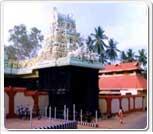
Attukal Pongala
Venue: Attukal Bhagavathy Temple
and its premises, Thiruvananthapuram city, South Kerala.
This video shows Pongala the annual festival celebrated
at this shrine on February 20, 2000. The word Pongala means to boil over and refers to the ritual offering that is most pleasing
to the deity a porridge of rice, sweet brown molasses, coconut gratings, nuts and raisins.
Only women are
allowed to participate in this ritual. Right from the previous night thousands of women, regardless of caste, creed and colour,
assembled in the temple premises and on both sides of the roads leading to the shrine to perform Pongala .
Getting
there
Nearest railway station: Thiruvananthapuram Central about 2 km from the shrine.
Nearest
airport: Thiruvananthapuram International Airport, about 7 km from the shrine
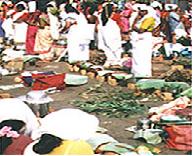
----------------------------------------------------------------------------------
ANANTHA PADMANABHA TEMPLE:
Tiruvanandapuram (Trivandrum) gets
its name from the grand Anantapadmanabhaswamy temple, enshrining the tutelary deity - Anantapadmanabha of the Travancore
kingdom. It is one of the grandest temples of Kerala, The Maharaja of Travancore built this famous temple with its seven-storey carved gopuram in the Dravidian style in
1733. There are innumerable pillars, intricate carvings and mural paintings of natural pigments. The temple is dedicated to
Vishnu who reclines on the sacred serpent Ananda. The image of Vishnu is 18 feet long and a lotus grows from Vishnu’s
navel and Brahma is seen in the lotus. Several arts forms like Krishnanattam, Koodiyattom, Pavakkoothu, Nokkuvidya, Velakali,
Kathakali etc. thrived under the patronage of Sree Padmanabha Swamy Temple. This temple enshrines an imposing image of Vishnu,
in the Anantasayanam posture;
; an
image viewed through three doors in front of the shrine. The original image was of wood; the current image was fashioned out
of 1200 saalagramams which were specially brought down for this purpose and moulded into shape with a special paste kadusarkara
- a mixture of lime, granite, molasses and mustard. Vishnu is viewed through three doors in a row - the face on the southern
side, the feet on the northern side and the nabhi (navel) in the middle. Padmanabhan is enshrined in the yoganidhra
posture, reclining on Aadiseshan -( making offerings of vilvam to a small Shivalingam, to his right).
The sanctum of this temple is fashioned in the style of the temples of Kerala, while the surrounding walls and the towers
resemble that of the Tamil (Dravidian architecture)temples. Interesting murals adorn the outer walls of the sanctum. There
are shrines to Narasimha, Hanuman and Krishna near the sanctum.
According to Historians, Martanda Varma of the Travancore Kingdom, in a spectacular
ceremony in 1750 surrendered the kingdom to the presiding deity of the temple, and received it back as a fiefdom and ruled
Travancore as a servant of Padmanabhan; all of his successors adopted this custom. Much of the present structure dates back
to the period of Martanda Varma, who made several renovations and built the eastern gopuram, which got completed by 1798.
The origin is believed as follows: A rishi by name Divakara Yogi, who was engaged
in the worship of Vishnu, was enraged by the sight of a two year old toddler swallowing his Salagramam, the object of his
worship. The toddler, upon being chased by the yogi, entered a tree; the tree split, and Vishnu revealed himself in all his
splendour to the Rishi, who then requested him to assume a form that could be held in worship, upon which Vishnu assumed the
form of the image, now held in worship in this temple.
The flagstaff is enclosed in a casing of gold. The Kulasekhara
mandapam near the flagstaff has fine sculptures dating back to the 17th century. The long prakaram, with a terraced roof with
324 columns, mesaures 540 feet by 325 feet, and is about 24 feet wide. It has two rows of granite pillars, and every pillar
bears an image of a Deepalakshmi. Also here are images of yalis (mythological animal), with non removable stone balls in their
mouths.
There are two annual festivals here - one in the month of Pankuni (Pisces-Meenam)
March 15-April14, and the other in Aippasi (Tulaa-Libra) (Oct-Nov).
Arattu at Sree Padmanabha Swamy Temple
Venue: Sree Padmanabha Swamy Temple in
the heart of Thiruvananthapuram city, South Kerala.
Pallivetta (royal hunt) and Arattu (holy bath) are important
rituals conducted during the festivals at some of the major temples of Kerala. The speciality of the Arattu
at the Sree Padmanabha Swamy Temple is that the head of the royal family of the erstwhile princely State of Travancore, still
escorts the procession of idols during the tenday festival. Cultural programmes include Kathakali performances.
Arattu festival is the
closing ceremony of the ten day festival in the Lord Padmanabha temple at Thiruvananthapuram.
There are two such festivals every year. One takes
place in the Malayalam month of Thulam (October-November) and the other in Meenam (March-April).
The Arattu is a ceremonial procession of the Lord at
the close of the ten-day-festival. The previous night, there is a procession called pallivetta inside the fort encircling
the temple.
On the day of the Arattu, His Highness the Ex-Maharaja
enters the corridor of the temple, and after some rituals, the procession takes out through the eastern gate with the accompaniment
of nagaswaram, drum etc.
His Highness with sword in hand and escorted by armed
guards, infantry, mounted police, officers etc. leads the procession to the Sanghumugham beach.
A caparisoned elephant goes in front with drum on its
back, that is beaten to indicate that the God is coming in procession. Six more caparisoned elephants follow. The procession
leaves the temple gate at about 5pm and a 21 gun salute is made. On reaching the beach the ceremonial bath is taken in the
sea.
Gettting there
Nearest railway
station: Thiruvananthapuram, about a kilometre from the shrine.
Nearest airport: Thiruvananthapuram International Airport,
about 6 km from the city.
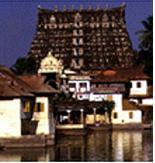
Janardhana Swamy Utsavam
Venue: Janardhana
Swamy Temple, Varkala, Thiruvananthapuram district, south
Kerala.
The Arattu procession comprising five caparisoned elephants and allnight kathakali performances
on the fourth and fifth days are the main attractions of the week long festival. This 2000 year old shrine dedicated to Lord
Vishnu is located in a picturesqe village by the Varkala beach.
The Janardhanaswamy Temple at Varkala is about three
kilometers form the Varkala railway station. The Arattu festival at this temple is celebrated every year in Meenam (March-April)
commencing with Kodiyettu (Flag hoisting) of Karthika day ending with Arattu on Uthram day. The festival lasts for ten days.
On
an average more than ten thousand people gather everyday to attend the festival. A colorful. procession led by caparisoned
elephants in which ornamental silk umbrellas, peacock fans etc. are carried, which is one of the prominent features of the
festival.
Getting there
Varkala is about 40 km from Thiruvananthapuram
city.
Nearest railway station: Varkala.
Nearest airport: Thiruvananthapuram International Airport, about 46
km from Varkala
KAPPALLY KUMBHAM THIRA
There is a temple
about half a kilometer to the east of the Kappally palayat temple. This is the Kappally temple where the Thira festival is
conducted annually from 3rd to 13th of Kumbham (February-March) every year. The most important day of the festival is the
12th of Kumbham.
Kodiyettu Utsavam At Thiruvarattukavu Bhagavathi Temple, Attingal
The Kodiyettu
Utsavam of this temple, dedicated to the Goddess Bhagavathy, is celebrated in memory of the consecration of the temple. Commencing
on the Makayiram day in Vrischikam, (November-December) it ends on the Uthram day.
Thiruvambadi Sri
Krishna Temple, Varkala
Sri Krishna one of the 10
‘Avathars’ (Divine incarnations) of Lord Vishnu is the presiding deity. It is located at Manthra near Varkala.
A festival is celebrated here in a grand manner.
KANYAKUMARI
The Temple at Suchinram 13 km north- west on the rail
/road route from Kanya- Kumari to Thiruvananthapuram is an important place of worship. The temple with its large entrance
Gopuram is quite magnificent. There are pillared Halls all around the inner Sanctum where there is the triple image of the
Lords Shiva, Brahma and Vishnu. The 10-day annual chariot festival is famous.
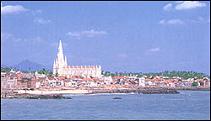
KUMARA KOYIL MURUGAN TEMPLE
This ancient temple to Murugan known as Kumaran
Koyil is located at Padmanabhapuram, home to the palace of the erstwhile Maharaja, on the slopes of the Veli hills. It is
located in a commanding position, visible for miles around.
Legend has it that Murugan married Valli here and
hence the name Velimalai, Manamalai or Kalyanamala.
Deities:
The main deities worshipped here are Subramanyar and Valli. A majestic ten
feet high image of Subramanyar of great workmanship adorns the sanctum. The festival image of murugan here is Manavaalakumaran
and this image is taken in procession every year during Navaratri to along with Saraswati and Bhagavati from the Padmanabapuram
Palace. Manavaalakumaran is also taken in procession to take part in the annual festival of the Suchindram temple.
Festivals:
Kerala Tantram is a protocol of worship offered in this temple along the
lines of most other temples in Kanyakumari district. Fridays, especially the last fridays of every tamil month are considered
to be very sacred here. The Kanji which is distributed here on fridays as prasadam is believed to have miraculous healing
properties.
Murugan's and Valli's marriage is celebrated with
great splendor in the month of panguni. This Tirukkalyanam is an enactment of the divine wedding and is attended by thousands
of pilgrims from allover the state.
The seven-day festival begin in the star of Anuradha
in the month of Panguni. Vaikasi Visakam is celebrated for 10 days and as in other Murugan temples Skanda Sashti is celebrated
for six days.
Pushpabishekam is celebrated on the last Friday
in the month of aavani when the image of Kumaran is completely covered with hundreds of baskets of flowers contributed by
the congregating pilgrims. Just one kilometre from Kumarakoil Temple on the same mountain road
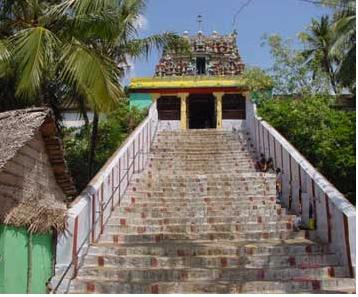
-----------------------------------------------------------------------------------------------------------------------------
Siva
Temple Aruvippuram
The idols in this temple were installed by Sri Narayana Guru.
‘Sivarathri’ festival during which devotees observe fast and forgo the night’s sleep and perform puja (offer
prayers and worship) and adore Lord Siva is famous here
Sri
Subramaniyaswamy Temple-Ullur
This temple
dedicated to Lord Subramaniya (Murugan) is situated 7 kms from Thiruvananthapuram.
-----------------------------------------------------------------------
Venue:
Sarkara Devi temple, Chirayinkeezhu, Thiruvananthapuram district, South Kerala.
Sarkara
Kaliyoottu Mahotsavam is the festival commemorating the fight between the demon Darika and goddess Durga. The event is enacted
in a thrilling ritual performance known as Paranettu, conducted by the heads of 64 villages. The combat is enacted in various
stages like Thampuran pulayan , Pulayan purappadu, Thampuran purappadu etc.
The
most thrilling part is the concluding Paranettu , which is an action packed and moving
ritual. The final fight and killing of Darika is enacted on a specially erected stage, about 100 feet high and is conducted
at night. The temple dedicated to goddess Bhagavathy , is noted for its mural collections
and wood carvings. Sarkara Bharani And Kaliyoottu
The famed Sarkara Bhagavathy
temple is situated at Sarkara village, near Chirayinkeezhu railway station. The festivals celebrated in this temple are Kaliyoottu
in Kumbham and Bharani in Meenam (February-March). Kaliyootu is celebrated to commemorate the fight between Darika and Bhadrakali.
Getting there
Sarkara
is about 35 km north of Thiruvananthapuram and about six km west of AttingalThere are frequent bus services to Chirayinkeezhu from Thiruvananthapuram city.
Nearest railway station: Chirayinkeezhu,
right in front of the shrine.
Nearest airport: Thiruvananthapuram International Airport, about 41 km from Sarkara.
Thiruvanparisaram is also known as "Thirupathisaram" and lies around 3 miles away from Nagarkoil.1.
Periya Pirattiyar, who is generally found on the right side of the heart of Sriman Narayanan, is found on the left side of
this Sthala Perumal.
2. Banyan tree is found near the Lakshmi Theertham, which is capable of curing diseases and it is
also said to be the Hamsam of the Perumal.
Thiruvanparisaaram has a relation with Tamil Nadu,
Kerala and Karnataka. This place is the birth sthalam of Udaya nangai, mother of Nammalwar. This perumal is worshipped and
the pooja is done by the Andhanars of
Udipi, in Karnataka.

|

